The Runes Of Doom, Part III
The Runes Of Doom, Part III
Class And Race In Arduin
The Culture of Post-Capitalist Hegemony Opens a Space for the Historicization of the Gendered Body.
I Got That From A Random Academic Sentence Generator
Here we are at Part III of the walkthrough of the third book of the classic Arduin Trilogy. Despite the title, we’ll probably only get through classes today, though if I’m feeling especially motivated, we might make this a double-sized end of year special. (EDIT: It is double sized, but we still only got through the classes.) We’ll see. Motivation and me, we get along like Deodanths and Elves.
Some Dead Horse Beating (Trigger Warning: Animal Abuse)
(Did you know the phrase ‘Trigger Warning’ is now considered to be ‘triggering’ because of guns? I swear to Hargrave and Gygax I am not making this up.)
Anyway.. beating said dead horse, a common trope among certain Old School Revisionists is that the trend towards a “rule for everything” is entirely a modern invention (and by ‘modern’, they mean, ‘anything that happened after the publication of My Favorite Edition’), and in the glorious days of yore, people just made shit up and were happy with it. The first part is true, for the same reason that people walked or rode horses before there were trains or cars. The second part is much less true, which is why we have trains and cars and 256-page core rulebooks.
As an example, with MANY uses of italics and CAPITALIZATION, so you people get the point:
While Dave might be drifting a little into excessive self-importance here… he was hardly the only one churning out new material for Dother roleplaying gamesons… he is correct in essence. Players, then and now, did not want to merely flavor text their thief and call it a ninja, nor did they want to engage in endless debates about precisely what a ninja could do. Multiple editions of D&D have started with some editorial diatribe about reducing class bloat from the prior edition, and each of them has gone on to do it anyway, because gamers like rules (and because you can’t sell people that which does not exist, unless you’re a religion, but I digress).
The quest for mechanistic individualization drives a lot of game design. It also drives the granularity of resolution systems, for there has to be space to grant a mechanical effect that is significant enough to actually come into play, but small enough that it does not overwhelm all other considerations. Doing this is not easy, as the design ‘sweet spot’ is ofttimes narrow, and players are good at finding synergies the designers never will, until it’s too late.
Anyway, on with the classes! But first, awesome art!
By the way, three of the four species pictured above will be covered in either this article, or the sequel.
Weird Al-Chemy
Sorry
(Not Really Sorry)
Having picked up the gauntlet on the issue of having rules in print for different classes, Dave Hargrave then proceeds to drop said gauntlet, burying it in an unmarked grave far in the outer wilderness. The Alchemist class text starts with the usual introduction about their armor limits (no armor), their weapon choices (no weapons), and their level titles (because that mattered a lot back then), and then, the meat of the matter, their actual class abilities.
Yeah. To be very clear, the “these” in “these are open…” refers to no prior set of rules or guidelines, but to the words just out of the image, “Special Acquired Attributes”. Having just noted how important it is for there to be rules in print, rules which have been “play tested and codified”, Dave then says, “Yeah, alchemists, they, uhm, they can make all this kind of stuff, but there’s no real rules for what any of it does (what’s the save on tear gas? How effective are medical poultices?), or what level they get it, or what the odds are of success, or, you know, anything.” This is similar to what I might, as a freelancer, get as an assignment — “Write up 2,000 words detailing this concept”. Dave, I am disappoint.
The Origin Of The “Assassins Do It From Behind” T-Shirt
Assassins are generally defined as people who kill for money. This is also how 99.99% of all PCs are defined, so the long and sustained existence of a class specialized in it seems odd, but it’s a big part of gaming history.
When Runes of Doom was published, assassins existed in Blackmoor, but we’re at the point where Arduin’s veering off towards its own system had begun. The small mutations to core D&D, added one to the other, pushed Dave’s game into a new direction. So, it is not surprising that we’re seeing, in the third book, Hargravian incarnations of established classes. (Indeed, with the exception of the Alchemist and the Sage, all the classes in Runes Of Doom were such variants.)
Assassins in Arduin are a subclass of martial artist (see here). Their main shtick is a limited choice of weapons, but good bonuses with those weapons, as follows: You can pick three weapons (not groups!), and you’re +3 with one, +2 with another, and +1 with the third, and then three weapons you’re “even on” with, or you can also pick another means of killing people (e.g., poisons or traps) and get the bonus with that, “loosing” your bonus with a weapon, or you can pick one weapon at +5 and forego your other bonuses (but keep the three ‘even on’ weapons) or (if you pick the +5 option) you can trade all three of your “even on” weapons for one “non-weapon” skill like poisoning, or you can forego all but one weapon at +2 and instead gain the Martial Artist’s unarmed attack abilities.
Got all that? (Oh, all weapons not picked per the above options, you’re at -2 with.)
The class description doesn’t say if there are any limits on weapons or armor; the assassin is a subclass of Martial Artist, but the weapon choices of a Martial Artist are up to the result of a player’s “Con DM” roll vs. the DM’s “Detect Bullshit” roll. So, given a compliant DM, one could create an assassin who starts off at +5 with “Two Handed Axe”. (Since the assassin must also have a ‘cover identity’ of another class, it’s very easy to justify being able to use the weapons and armor of that class.)
Furthermore, the assassin has a “cover” identity and “is thus a ‘dual’ character type”. You can only gain assassin XP by performing paid hits, at a rate of 1000XP per level of the victim about your own, and 250XP “per level below”, but I assume is meant to mean “-250 XP per level below, so four or more levels below gets you nothing”. (I say, pick a “cover identity” as a fighter, get +5 to your primary weapon, and don’t even worry about gaining assassin XP!)
Funny, You Don’t Look Druish
Continuing the trend of “Dave’s Versions Of Classes Established In The Other Rules”, we have the Arduin Druid. (There were “new Druid spells” in the Arduin Grimoire and Welcome To Skull Tower, which pretty strongly hints Dave was using the “other” rules for Druids before making his own.)
First, some backstory. I love these snippets of history; they create a context that is more inspirational than restrictive.
The druid level chart follows. There are no XP values given, but there’s one back in the Arduin Grimoire, so that’s that. (I just noticed that Assassins don’t get cool level names like most of the other classes do. What’s up with that?)
The “Detect Hidden Injury” thing is just weird, as there’s really no rules for “hidden injuries”, and the timing formula seems bizarrely specific, as if minutes would matter greatly. Maybe there’s an “internal bleeding” chart somewhere in Dave’s notes, with damage accruing on a minute-by-minute basis, so how fast you can find the “hidden injury” determined life or death? I dunno. (A common phenomenon (doop-do do-do-do) in old school games are subsections of rules written by a friend of the author who specializes in an area of knowledge, producing over-detailed mechanics to reflect the years they’ve studied the topic. Sort of like asking me to write the programming rules for a Cyberpunk game. I’d have two pages of modifiers for converting from one language to another, and a “critical .config file failure” chart for how long it takes to get the damn IDE to find all the included library files. But I digress.)
More marvelous backstory, nicely upending one of the most common cliches of stock fantasy settings:
In other words, if Tom Bombadil had met Legolas, there would have been… trouble.
BTW, if you’re annoyed at the spelling of “forest” throughout this section, just wait for…
Only You Can Prrevent Forrest Firres
The “Forrester (Woods Ranger)” class is next up. They are “solitary and nomadic”, don’t generally go into dungeons, but they may be wilderness guides. As noted way, way, back in the Arduin Grimoire walkthrough, it was common practice for players to have multiple characters, so they’d bring out Arragonn when the campaign moved to the Forrest Of Generric Slightly Crreepy Name, then switch back to someone useful when they got to the Dungeon Of Many Adjectives.
Forresters get a +1 to +3 on their Str and Con (not to exceed 18), can travel 33 1/3% (that extra 1/3% matters, damn it!) further than anyone else (making their utility as ‘wilderness guides’ somewhat suspect… they’re either way ahead of the people they’re guiding, or this ability is nigh-useless outside of solo play… it’s good for worldbuilding, knowing your Forresters can bring news faster than the enemy can travel does have an impact on things…), and they can “hear” on a 1-3 on a d6, which is one of the approximately 561 1/3 different “detect stuff” mechanics in use during any single gaming session back then. This number increases sporadically with level. They gain a handful of other abilities, such as speaking with animals (you have to pick the species, which leads to some interesting arguments… do wolves speak dog, or fox? Maybe with an accent?) At 20th level, you get to speak with plants, again by specific type… some DMs would let “trees” be a type, other DMs would insist on learning oak, birch, and pine as separate types, and real hard-ass DMs who didn’t want you ruining the game with this overpowered munchkin ability would probably break it down to the level of “Northern Arduin Red Oak”,
Otherwise, not too much of interest.
TRUE Paladins
Not Those FAKE Paladins In Other Games
Paladins are not “fighting clerics”, says Dave, but “warriors with a near-mystical religious fervor”, which has not previously been “delt”(sic) with. In other words, Paladins were falling far short of their potential for game-disrupting antics and “but I’m just playing my character!” excuses for burning orphanages.
Let me praise Mr. Hargrave for designing a class defined as it was often actually played. In Arduin, Paladins are “berserk warriors with overtones of the Witch Hunter”. Yup, that about does it. Regardless of presumed models such as Lancelot, the average Paladin, in practice, was all about slaughtering baby orcs and bisecting random NPCs on suspicion of heresy. So why not make the class abilities and fluff text fit actual play?
They will also fanatically harangue and harass all not of their faith to convert, and are quick to condemn any hint of deviation or heresy, making them the first Tumblr users. As an additional benefit, they ignore the detailed rules for social class and starting gear we discussed earlier, but instead start off with equipment determined by their own, custom, chart, including a guarantee of at least a light warhorse.
They do gain some special abilities, besides their fighting skills.
The Paladin gains mana equal to three times their strength, and it takes mana equal to the level at which an ability is gained to invoke it, so a Str 16 Paladin starts with 48 mana (!) and thus can cast Cure Light Wounds 48 times(!!) at first level. Whoa. Dave… you, ah, you playtested this? Sure about that? (To be fair, this number will increase only slowly with level; even in Arduin, attribute score raises were not regularly doled out. Even so… )
And here’s an image Erol Otus drew for the first edition of the Arduin Grimoire, published in The Runes of Doom. Why not? (Erol’s art suffers from the thin inking; his stylized, two-dimensional imagery benefits from the heavier, thicker lines we see in his work for TSR and others. I don’t know if he did his own inking and changed his style, or if someone else inked his pencil work.)
(In Part XII of Welcome to Skull Tower, I noted that Arduin medusae got “biz-zay” (as the kids these days say… do they still say that? Damn kids, always changing their slang). So did gorgons. Hybrid creatures of all types have always been popular in D&D variants; Gygax promoted the concept early on, in the Greyhawk supplement (the ‘little brown book’, not the campaign setting), and I adore the template rules for 3.x and PF. Completely unrelated to anything here, and of no benefit to me, as I have no financial or personal connection to the company, Green Ronin’s “Advanced Bestiary” is my instant answer to the “if you could have only one third party supplement” threads that start up all the time on various fora. (I have no kind of ad linking or revenue sharing going on; it’s just a great book if you play Pathfinder.))
Sage
No Parsley, Rosemary, Or Thyme
Though If Anyone Were To Invent A “Thyme Lord” Class, It Would Be Me
At the time of the writing of the Trilogy, there really wasn’t much concept of an “NPC Class”. Further, the first iterations of the concept were for classes too powerful to be used as PCs, not for classes too weak. To the surprise of no one who understands human nature, esp. the nature of the adolescent munchkins who formed a large plurality, if not the majority, of the 70s D&D audience, this “restriction” never stuck, and “NPC Classes” from The Dragon, like Ninjas and Anti-Paladins, showed up as PCs with great regularity, provided the Chinese food payments kept coming,
The Arduin Sage is a good example of what today would be an NPC class — a way to give mechanical definition to someone with useful skills, but who isn’t going to be tromping down into the dungeon.
Sages pick one of seven broadly defined areas of study, and, since there’s no actual ‘Lore’ or ‘Knowledge’ skill in the game yet…
The plethora of micromechanics (such as the Paladin’s rules for going berserk, or the Sage’s knowledge rules) are, individually, easy to handle. When people defend this style of game design as “easier” than having more complex, but more inclusive, systems, they usually compare a single microrule to the entirety of, say, the Knowledge Skill rules, and point out how simple it is. Except there’s dozens, or hundreds, of such rules, and each is designed atomically and without regard to its interactions with similar rules. (I have this problem in my day job as a programmer… I work with legacy code where the choice was constantly made to solve the same problem a dozen times in a dozen slightly different and incompatible ways, the argument being that writing specific code for a specific task takes less time than writing a generic routine or class… without considering that taking slightly more time writing a generic solution saves constant recreation of the same code. But I digress.)
Remember how I dinged Dave for not actually providing rules for the Alchemist’s abilities?
Yeah. About that.
And Thus..
We end our study of class in Arduin. We’ll get to race next week, it seems. This article is already a good bit longer than most. And while the classes in Runes Of Doom are mostly minor recreations of established standards, the three new races added are anything but.


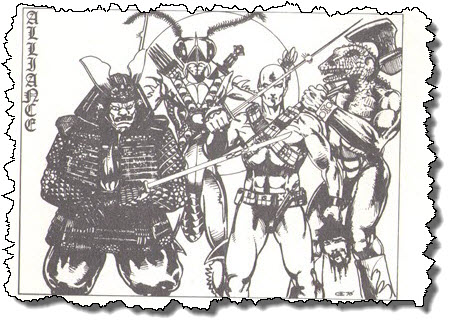

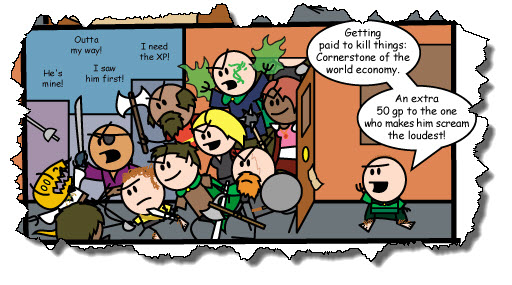
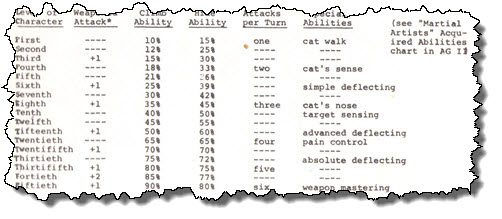

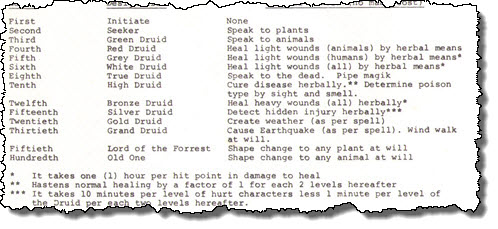





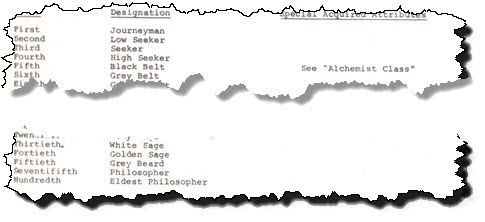
Pingback:The Runes Of Doom, Part IX | Lizard's Gaming and Geekery Site